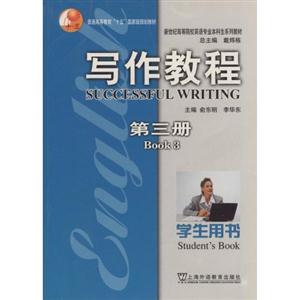-
>
通宵俱乐部-签名本
-
>
2022读者节纪念徽章-一星会员专属
-
>
20世纪中国短篇小说选集(全6册)(八五品)
-
>
(精)方力钧作品图录
-
>
“囤书者说”藏书印章系列-谢绝外借
-
>
(精)赵丹书画选
-
>
中图网文创礼包-“民国名家画谱”藏书票贴纸(2张)
写作教程第三册学生用书 版权信息
- ISBN:9787544602112
- 条形码:9787544602112 ; 978-7-5446-0211-2
- 装帧:暂无
- 册数:暂无
- 重量:暂无
- 所属分类:
写作教程第三册学生用书 本书特色
《写作教程(第3册学生用书)》特点:理念新颖:培养高素质、复合型外语创新人才为理念;特色鲜明:将人文、科学知识融入教材;体系完备:覆盖知识、技能、文化等科目,总数超过150种;阵容强大:全国30余所著名高校百余位英语教育专家编写。
写作教程第三册学生用书 目录
写作教程第三册学生用书 节选
《写作教程(第3册学生用书)》是《新世纪高等院校英语专业本科生系列教材)》之一。《写作教程(第3册学生用书)》贯彻“以功能文体为突破口的跨文化交际法”。《写作教程(第3册学生用书)》共分十八个单元,每个单元包括五大板块,分别是导言、范文、写作技巧、课上写作和课后作业。此外,每单元还精选了“名言”,用于加深对单元主题和写作技巧的理解。
写作教程第三册学生用书 相关资料
插图:The job I took after my freshman year at college was certainly satisfying in terms ofpay and schedule. This job, in the office of a vocational center for women, attracted memainly because the pay was so good. As for the schedule, I never had to arrive earlier than9 A.M. or leave later than 5 P.M. After about a week in this job, however, I was bored.Since ! did not have a social work degree or counseling experience, I was not allowed towork with clients. Instead, my duties were to handle the office's paperwork. I keyboardedand filed correspondence and filled out countless forms. I soon realized that the good payand the pleasant schedule didn't make up for my general job dissatisfaction. The timeseemed to creep by.When I began my job hunt at the end of my second year in college, I looked less at thepay and schedule of available jobs and more at whether the jobs had any people contact.Luckily, I found what ! had been looking for in a job waiting on tables at the local coffeeshop. Compared to the office job, waiting on tables did not shine in terms of pay or sched-ule. Although my average weekly pay was roughly equal to my office salary, the pay variedfrom week to week because 1 depended on tips for much of my income. Additionally, myschedule was more hectic~ than the office schedule had been. The hours were longer, and worked odd shifts~ that changed from week to week. Even with the unpredictable payand hour, however, I enjoyed my job. Juggling~ different tasks and being on my feet allday were demanding, but time passed very quickly. Moreover, the job gave me ample op-portunity to use my skills with people. I loved the contact I had with customers. These fa-vorable working conditions far outweighed the disadvantages of less steady pay and morestrenuous work than my old office job.Now when I look for jobs, I consider three factors: pay, schedule, and job satisfac-tion. My office job offered good p
- >
中国历史的瞬间
中国历史的瞬间
¥23.5¥38.0 - >
莉莉和章鱼
莉莉和章鱼
¥16.0¥42.0 - >
烟与镜
烟与镜
¥28.4¥48.0 - >
朝闻道
朝闻道
¥11.7¥23.8 - >
随园食单
随园食单
¥20.6¥48.0 - >
山海经
山海经
¥20.4¥68.0 - >
大红狗在马戏团-大红狗克里弗-助人
大红狗在马戏团-大红狗克里弗-助人
¥4.4¥10.0 - >
龙榆生:词曲概论/大家小书
龙榆生:词曲概论/大家小书
¥9.1¥24.0
-
2022图书×抽奖盲袋
¥9.9¥25 -
2023读书月阅读盲盒——天黑,闭眼,刀谁?
¥42.3¥158 -
2022读者节纪念徽章-三星会员专属
¥45¥45.6 -
2023读书月阅读盲盒——我什么场面没见过?
¥42.3¥158 -
2023读书月阅读盲盒——去码头整点什么薯条?
¥42.3¥158















